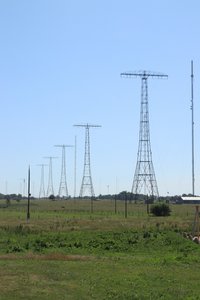Advertisement
Published: October 9th 2020

 The antennas
The antennas
The antennas they used are more than 100 meters highThe only survivor
The
Grimeton Radio Station is a piece of industrial heritage which is so unique that it has been listed as a world heritage site by UNESCO. Emma is not very interested in old radio stations so when Ake went to Grimeton Emma spent the time at an outdoor recreation centre a few kilometres away.
In the 1920-ies it was possible to build long wave radio transmitters so powerful it was possible to send radio signals across oceans. This technology made it possible to send messages from one end of the world to another alsmost instantly. The messages could only be sent in Morse code, but was still far superior to any other communication technology available at the time. In a few years a network of radio stations using this technology was established. One station in this network was built in Grimeton in Halland district in southern Sweden.
This technology became obsolete after only a few years and was then replaced by better, cheaper smaller and more efficient equipment. Once there was no longer any use for the long wave radio stations they were all closed down and the mighty antennas were dismantled

 Just trying to capture a cool photo
Just trying to capture a cool photo
I saw a photo opportunity and had to have a go at itand the large bulky equipment was scrapped. It happened everywhere except for Grimeton Radio Station. The Swedish navy found use for the station and took over everything.
Thanks to that Grimeton Radio Station survived into the 21st century. It is the only surviving radio station of its kind from the very brief period when long wave radio was the state of the art in communication technology. What makes this place even more spectacular is that everything is still in working order. At special occasions they fire up the old radio and send a message or two across the ocean in direction to New York City. Well, there is nobody there to receive the message of course because the New York station was closed down almost 100 years ago.
Most people who visit Grimeton are fascinated by the antennas. There are five of them and each one is well over 100 meters high. But if you are interested in technology the old radio equipment is also very interesting. This technology is truly a dinosaur. It is large, inefficient and grotesque. It is no wonder that it became obsolete in just a few years. But it
is really cool to see it. I mean, it was cutting edge technology in the 1920-ies.
It was also fun to see the supersized tools they used when they did maintenance work on the equipment.
On one of the walls inside the station building they had names displayed. Those names were of other radio stations that they communicated with back in the days.
I mentioned above that Grimeton is in Halland. It is 15 minutes drive from the town Varberg. Varberg is a rather small town that has been blessed with several tourist attractions. Not far from Grimeton Radio Station is a place called Bexell's Talking Stones. We will write about those in our next blog entry. Varberg also has a museum which holds two artefacts which are pretty well-known in Sweden. Those are the
Bocksten Man, the remains of a man who lived in the 14th century and whose well presearved body was found in a peat bog in the 19th century. The other is an improvised bullet, made from a button, that according to legend was the bullet that killed king Charles XII of Sweden during a siege in Norway.
Advertisement
Tot: 0.08s; Tpl: 0.012s; cc: 18; qc: 25; dbt: 0.0403s; 1; m:domysql w:travelblog (10.17.0.13); sld: 1;
; mem: 1.2mb

 The antennas
The antennas
 Just trying to capture a cool photo
Just trying to capture a cool photo
 Grimeton Radio Station
Grimeton Radio Station



























Daniel Tingdahl
non-member comment
Wow!
That's a great place to visit! Me and my family were there this summer 2020. They've done a great job making the place worth visiting both for "technical nerds" like myself, and for adults who just want to learn more about a past that has almost been totally forgotten. Even kids just wanting to activate themselves can have a great time here!